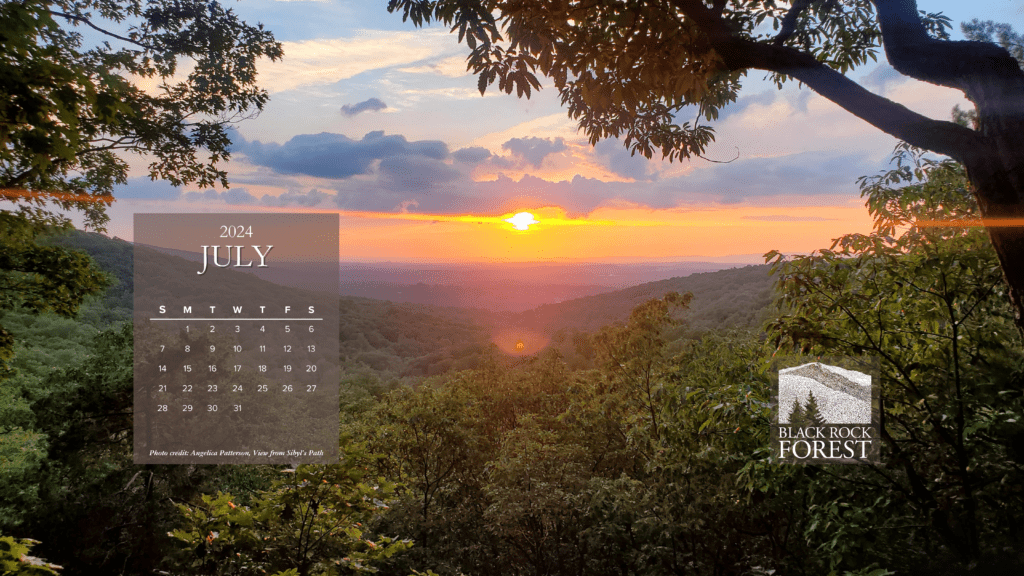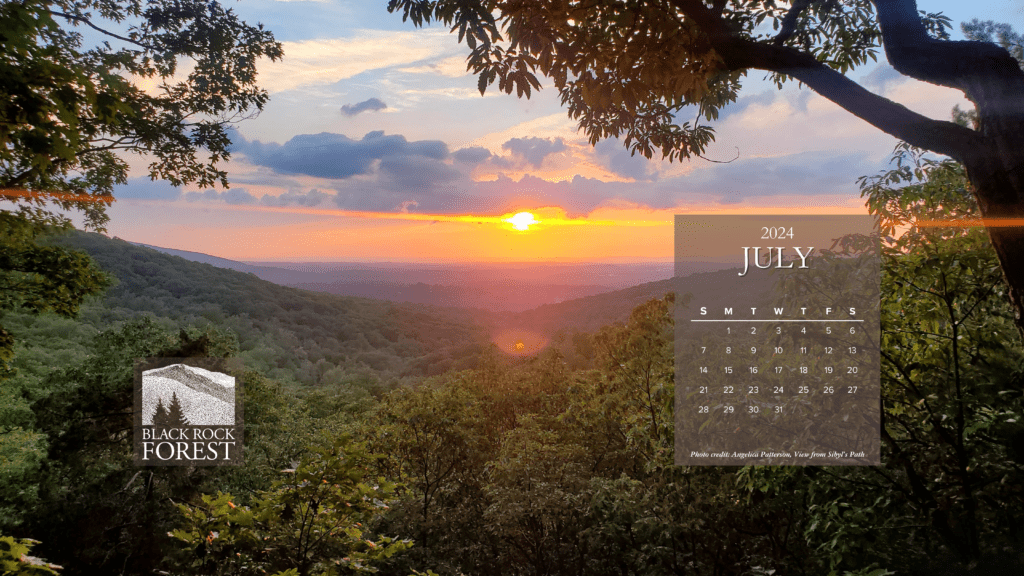Blossoming Futures:
Building a Classroom Garden at Black Rock Forest

June 20 was the summer solstice, and a good time to remember that nature learning should happen in all seasons, particularly when summer learning loss, aka “summer slide” can lead to a decline in academic skills over the months students are not in school. A summer garden is a great way to engage students of all abilities by providing them with a variety of sensory experiences, plus it can help boost local pollinators. We were awarded funding to start our own classroom garden from the Scotts Miracle-Gro Foundation and KidsGardening, and the Orange County Think Differently collaboration.
We have started building a youth garden next to our Forest Lodge, with a focus on native plants for forest pollinators. The accessible garden will increase opportunities to engage students near the Forest Lodge and Moretti Education Center (a laboratory and classroom space). This summer, we will be hosting the Newburgh Enlarged City School District (NECSD) in their four-week Empire Extended School Year Program, through which we will use the garden as a teaching tool for up to 90 visiting Newburgh students (Gr. 3-8). Throughout July and August, we are also partnering with Town of Newburgh Recreation, City of Newburgh Recreation, MARCS Friends, Newburgh Free Library, and the Newburgh Armory Unity Center to offer field trips to students of all ages.
We are designing an educational curriculum centered on the value of pollinators, composting, and native plants. In particular, we are excited to incorporate the latest research on the value of forest pollinators, such as forest bees and hummingbirds, for this summer science enrichment of Newburgh students.
Our garden will include native plants from our community partners at the Wild Woods Restoration Project: Tall Thimbleweed (Anemone virginiana), Boneset (Eupatorium perfoliatum), White Wood Aster (Eurybia divaricata), Wild Geranium (Geranium maculatum), Monkeyflower (Mimulus ringens), Wild Bergamot (Monarda fistulosa), Blue-stemmed Goldenrod (Solidago caesia), Seaside goldenrod (Solidago sempervirens), Zigzag goldenrod (Solidago flexicaulis), Blue heart-leaved Aster (Symphyotrichum cordifolium), New England Aster (Symphyotrichum novae-angliae), Late Purple Aster (Symphyotrichum patens), Rose Milkweed (Asclepias incarnata), Butterfly Weed (Asclepias tuberosa), Common Milkweed (Asclepias syriaca), Mountainmint (Pycnanthemum sp.), Wild sunflower (Helianthus sp.), Pussytoes (Antennaria plantaginafolia).
– Jessica Schnell, PhD, Director of Education, Black Rock Forest
Acknowledgements:

Promoting Pollinators in Black Rock Forest

Pollinators are an essential component of a healthy ecosystem, but loss of habitat, use of pesticides, and changes in climate are causing precipitous declines in many species of butterflies, bees, and moths. Recent studies have shown the often-underappreciated role that forests play in supporting pollinator habitat by providing over-wintering and nesting habitat and food sources early in the spring when trees blossom (Ulysgen at al. 2023). A survey in 2003, documented an amazing 138 native and 6 exotic species of bees in Black Rock Forest (Giles & Ascher 2006)!

Open gaps within and edges along forests are particularly important for pollinators because these areas often support the flowering plants that our pollinators need (Ren et al. 2023). In Black Rock Forest, peaks in the abundance and diversity of bees were found in open areas. Forest visitors and students often see this phenomenon firsthand as they visit the open areas near the reservoirs that are teeming with bees, butterflies, and other pollinators.
Forest edges and gaps are increasing throughout Black Rock Forest as pests, pathogens and the subsequent waves of tree mortality follow, particularly in white ash (Fraxinus americana), eastern hemlock (Tsuga canadensis); and American beech (Fagus grandifolia). While the loss of these trees can be devastating, as land stewards, we must adapt our management practices for these events. We are exploring how best to enhance habitat, control invasive species, and support revegetation of native species in forest gaps. Invasive species management, planting preferred native species, limiting browsing by deer, creating pollinator fences and building brush piles, and reducing the mowed areas around our buildings are all efforts we are implementing to attract and sustain pollinator populations. And now with the creation of our new garden classrooms, we can incorporate what we are learning directly into our new education curriculum, introducing students to the importance of native plants and pollinators (see the garden article in this newsletter). All of these efforts and more, help us ensure our forest remains resilient, robust to future challenges and brimming with diversity.
– Matthew Brady, Forest Director, Black Rock Forest; Isabel Ashton, PhD, Executive Director, Black Rock Forest; and Scott LaPoint, PhD, Director of Research, Black Rock Forest
Acknowledgements: This work is being contracted by the Lower Hudson Partnership for Regional Invasive Species Management using funds from the Environmental Protection Fund as administered by the New York State Department of Environmental Conservation.
Tracking Early Blooms:
Red Maple Phenology and Climate Change Insights at Black Rock Forest

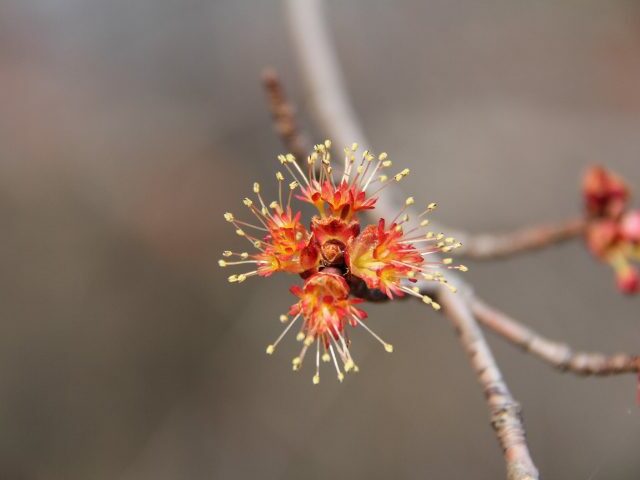
Changes in phenology, or the timing of cyclical events in nature, can reveal how some species may adapt to climate change impacts while others suffer. Quantifying these changes though can be challenging, often due to the large number of observations that are required. Black Rock Forest staff and our volunteers have been collecting phenology observations since 2021 by walking our mile-long “Phenology” trail recording data on 15 individual plants representing five species. Staff and volunteers record our observations of simple questions on presence, absence, and proportion via the Nature’s Notebook app. Because these observations are associated with a date, we can explore when the flowers of red maple (Acer rubrum) trees are first observed; i.e., changes in the ‘timing’ of red maple flowering events.

Although we only have four years of data so far, it seems that red maples in Black Rock Forest are flowering earlier every year (purple diamond) as are red maples across the region (green boxes) (Figure 1). While being able to capitalize on an early spring may have advantages (e.g., sprouting leaves or flowers before your neighbors), these trees become vulnerable to the increasingly variable late-winter snow and cold events. Shortening winters can facilitate the spread of invasive species, pests, and pathogens. These data allow us to better understand our forest and better prepare us for our future forest. A big thank you to our volunteers who have recorded over 60,000 observations!
–Katie Terlizzi, Research Manager, Black Rock Forest
Black Rock Forest Celebrates Conservation Science at Tavern on the Green!
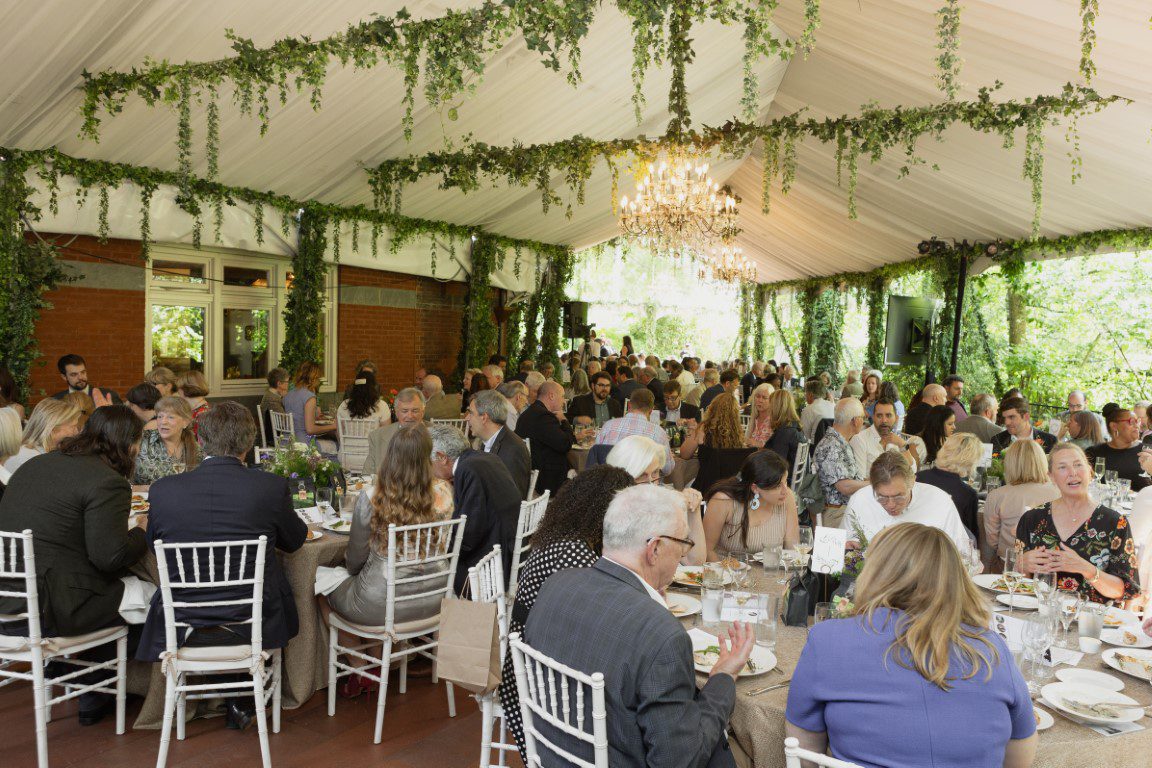
We were delighted to have nearly 150 friends of Black Rock Forest join us on the terrace of Tavern on the Green to enjoy one of the first warm days of May and “Celebrate Conservation Science” at our annual benefit luncheon! Together we raised nearly 10% of our annual budget – critical funds to support the conservation, research and education work that we do here at Black Rock Forest. Please enjoy the photos and, if you were not able to attend, the video from the event: CLICKING HERE.

It was also special to be gathered to celebrate the life of David Redden, who will be deeply missed by us all. This year, David and Jeannette Redden were our distinguished honorees of the Dr. Ernest G. Stillman Award for Outstanding Contributions in Leadership & Conservation in New York.
It was wonderful to hear our Keynote speakers, awardees of the David Redden Conservation Science Fund Small Grants Program. Their projects ranged from studying carnivores like the gray fox; investigating water use efficiency in trees, researching how trees adapt to our rapidly changing environment; and discovering a new species of wasp parasites (for which a trigger warning was needed in advance of showing the slides!)
As Isabel mentioned at the luncheon, we were thrilled to be able to gather at this event with so many friends to further Black Rock Forest’s efforts to, “invest in the future of science, discovery and education.” Thank you for your support!
–Brienne Cliadakis, Director of Development, Black Rock Forest
Black Rock Forest Board Announcements:
Christie Van Kehrberg Steps Down and Kim Elliman Joins the Board

Christie van Kehrberg, retired from the Black Rock Forest Board of Directors in March of this year. At the June Board meeting, the Board adopted a resolution to honor Christie’s decades of service, beginning from the establishment of the Consortium. With this resolution, the Board reminded the Black Rock Forest community that we have, “benefited profoundly from [Christie’s] impressive mind and memory, and from her frequent help in conceptualizing and evaluating the organization and focusing and articulating its mission and fostering its diverse programming and activities.”
Christie’s involvement with Black Rock Forest began when she served as the assistant to our founder, William T. Golden. For many years – though 2019, Christie served as the Secretary of the Board of Directors and after that as a board member at large. She brought to her service her love of the natural world and zeal for adventurous hiking and traveling in the great outdoors, throughout the Hudson Highlands and beyond and, especially, at Black Rock Forest, itself. The Board extended its deepest appreciation and gratitude to Christie for her dedicated service and friendship.

Although Christie will be sorely missed, we are honored to announce that Christopher “Kim” Elliman has agreed to join the Black Rock Forest Board of Directors. Kim recently stepped down as the Chief Executive Officer of the Open Space Institute (OSI) where he will be followed by former New York State Parks Commissioner, Erik Kulleseid.
Kim is already known to us as he served on the Board two decades ago from 2004 to 2009 and he has also been a Preserve Board member (which solely manages the land and buildings of the Forest) for the last 15 years. The depth of knowledge Kim brings from his decades of service at OSI, working to protect and conserve land, and helping Black Rock Forest with its own land management concerns, will be invaluable in this new role. We are thrilled to have him join our Board and team.
–Brienne Cliadakis, Director of Development, Black Rock Forest
One Year Later: Storm Recovery Update
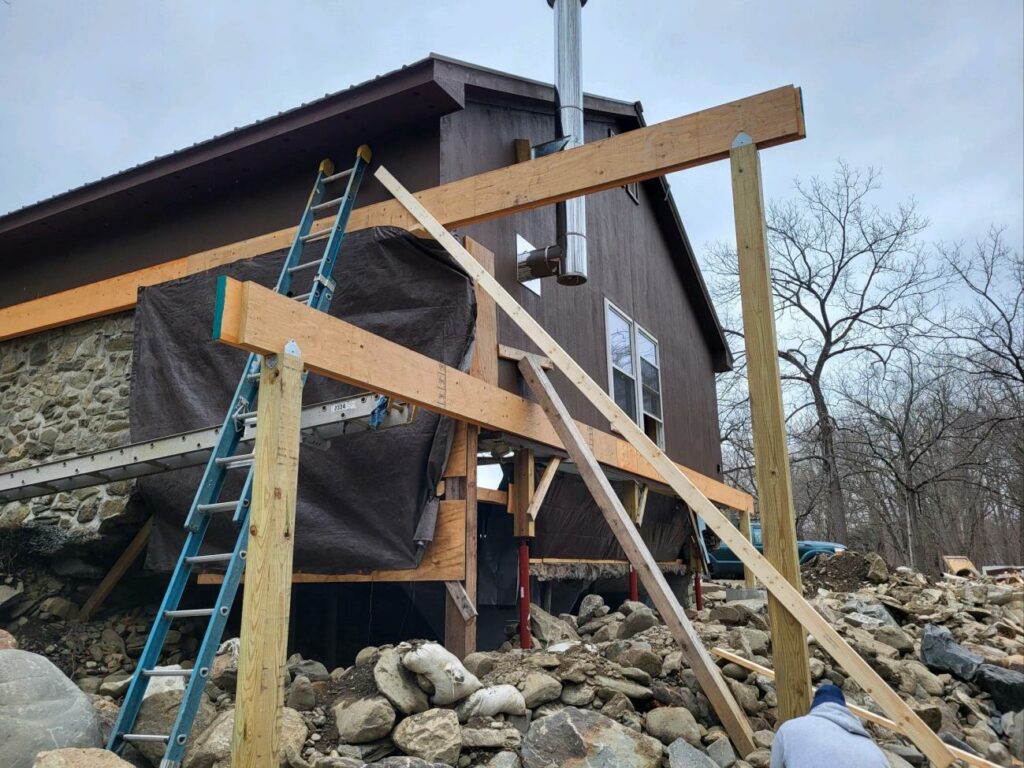
In July 2023, a heavy rainstorm and the subsequent flooding caused damage to Black Rock Forest’s trails, roads, and buildings. We have spent a year collaborating with the Federal Emergency Management Agency (FEMA) and New York State Division of Homeland Security and Emergency Services on recovery operations. Matt Brady, the Forest Director, has been working hard to replace damaged culverts, improve road surfaces, and stabilize the maintenance shop with a goal of making the forest more resilient to future storms. We have a lot of work still to do – the damage was done in just a few hours, but disaster recovery takes years. Thank you for your patience and continued support.
Is There a Doctor in the Forest? Yes, a Few!

The summer of 2024 saw five newly anointed PhDs whose dissertation research featured Black Rock Forest. We will miss seeing them in our forest and labs but look forward to learning more from them as they all embark on the next stages of their research careers. Congratulations to you all!: Dr Brandon Alveshere (University of Connecticut), Dr Sarah Bruner (Columbia University), Dr Kenneth Davidson (Stony Brook University), Dr Ayo Deas (City University of New York), and Dr Ethan Tolman (American Museum of Natural History – City University of New York).
Black Rock Forest Digital Calendar Wallpaper
Check out our digital wallpaper with calendar months July, August and September now available for download. Featuring images submitted by photographers Angelica Patterson (former BRF Education Director), Kevin Dumont and Cathy Marczyk of Black Rock Forest. Thank you to our volunteer photographers!!!
Calling all Black Rock Forest photographers! We are looking for high resolution photos taken throughout the year of Black Rock Forest. If you would like to have your Black Rock Forest photo considered for a future digital wallpaper featured in our seasonal newsletter CLICK HERE.
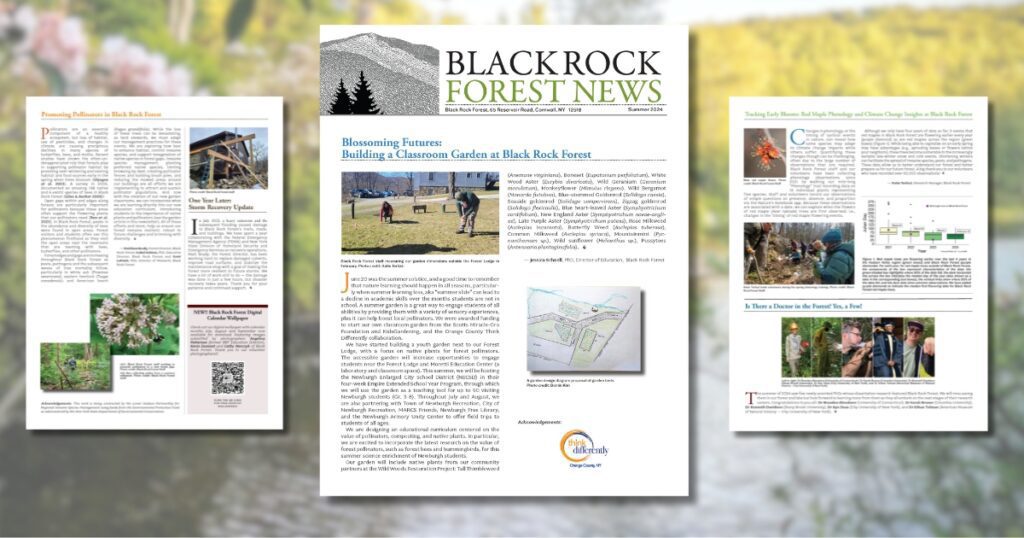
If you would like to download a copy of this Summer 2024 newsletter CLICK HERE.



